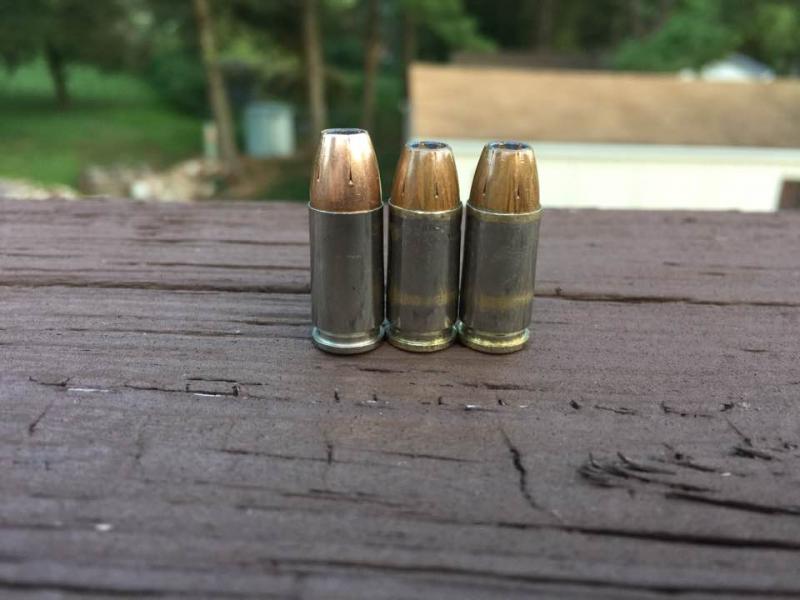There are many factors, in order of importance:
1.
Drawing to a bad grip - Practically every person who deploys a handgun for self defense is drawing that pistol in a real hurry, and doing so without having spent a lot of time actually practicing that skill. For police officers, the last time many of them actually drew and fired a shot was whenever the last qualification was. Something that is not recent and relevantly trained is going to be difficult to access when life is on the line.
As a result, when the go signal comes they grab at the gun spastically and throw it out at the threat
as fast as they can't. One or both hands are typically on the gun in a suboptimal fashion, often with digits in the way of the movement of the slide.
When concealment is involved you often see the cover garment tangled up with the pistol as well since properly clearing the garment and keeping it clear during the critical points of the concealed draw aren't happening. Also on the concealed side you see all sorts of bizarre behaviors that are completely unconscious. This is one of the reasons why I'm teaching
specific draw clinics for a small number of students per session as it usually takes an outside observer for them to realize they're doing counterproductive things like using their strong hand to clear the garment, then handing the garment off to the weak hand, and THEN finally getting to going for the gun with the strong hand.
Very few people toting a handgun for self defense...even a good many who have had formal training...have a real
process for the draw. They don't really understand what they're trying to achieve with a draw (namely landing in a reliable fighting platform) and so it's not surprising that without understanding the end state they struggle to have a reliable and efficient process to build that end state.
The gun runs better, shoots better, and is much harder to take away from you if you have a good grip on the gun. Thus it would be a good idea when building a defensive draw to emphasize getting as much of a proper grip on the gun
before it ever leaves the holster as you can. Unfortunately when people do actually train the draw they train to do it "fast" with suboptimal approaches that are counterproductive for actually fighting with the gun. These can sometimes produce good times with a hit, but they tend to fall apart under real stress. (Like at the man-on-man shootoff in the Tactical Conference match)
2.
Lubrication - If I checked 100 carry guns at random...duty or civilian carry...I'd wager I might actually see something approaching proper lubrication on maybe 2 in that 100. Lubrication does not reduce wear on firearms the same way that lubrication reduces wear in combustion engines. It does, however, help move unwanted particulates away from important working parts and smooth the operation of the working surfaces of the gun giving it the best shot at functioning. Proper lubrication helps the system run more reliably. When was the last time you applied lubricant to your carry pistol?
The lubricant migrates, evaporates, and wicks away on clothing or in the holster eventually. Typically you will see lube accumulate at the muzzle end of the pistol because gravity. Some have noted this and decided they will cheat the system and use grease, not realizing that grease is just oil suspended in a binder and that the oil component does the exact same thing as the oil component in liquid lube (migrate, evaporate, wick away) but leaves a binder behind that will provide absolutely no lubricative qualities but does a bang-up job of holding on to unwanted particulates right where you do not want them.
I've seen quite a few guns over the years that were shut down because they were greased, usually with some pretty shit-tier "I read about this on the internet" options.
I know, I know. X is a gunsmith/operator/armorer/famous instructor and recommends using grease. That's all fine and dandy except none of those people are STLE certified lubrication specialists or tribilogists...those being the people who actually understand how lubrication works. I hang with an STLE certified lubrication specialist on a regular basis and got red pilled.
3.
Maintenance - While firearms are not the most complex mechanical devices in the world, they still require proper maintenance to have any hope of functioning. One can throw cleaning into this category, but if point number 2 is addressed properly the cleanliness of the firearm doesn't matter very much until you've accumulated a lot of crud from shooting. It's rare that a duty gun or carry gun will end up with stoppages or malfunctions because it has been shot so much without cleaning that, say, the extractor can't operate because there's so much accumulated crud under it that it won't work.
In general "maintenance" usually means failing to replace parts on a proactive basis, springs especially.
Some departments have very good armorer programs. They tend to be the exception. In general if you go to a department at random and find an officer who was issued a Glock pistol five years ago, you will find that none of the springs in the gun have been changed...to include the magazine springs. And if all that officer ever did was fire at qualifications and mandatory training amounting to 250 rounds per year (which is generous, sadly), then his pistol has only fired 1,250 rounds so it is well within the round count advised for all the wear items in the gun.
Which makes sense...until you actually start to think about this for a minute.
Objects at rest stay at rest unless acted on by an outside force. Every time the officer walks, runs, drives in a vehicle, runs up or down stairs, impacts the ground taking down a suspect...the rounds in his magazines are bouncing around inside his magazines. That means the magazine springs inside his magazines are getting compressed and decompressed
constantly. Not completely, of course, but it doesn't take completely to wear out the springs.
Thus when he goes to qualify/train in year 5 his Glock stops locking to the rear on empty and he experiences stoppages on the range and he's not sure why. I mean, he's carrying a G17, right? They never have issues!
Well, they actually do if you beat the shit out of the magazine springs. And it's a guarantee he was issued three magazines with his pistol and that all three of them are on his person every minute he's on duty, save for when he has to take his duty belt off for a bathroom break or something.
"Hey, wait, TC...I carry every day and do all the same stuff except maybe taking suspects to the ground. Does that mean my magazines are getting the shit kicked out of them, too?"
Yes.
And that's why I have dedicated carry magazines and they get new springs once a year. Could I go longer? Probably. Do I care to find out how much longer I could go when the consequences are my gun not working when I really need it?
Absolutely not. A gunfight is a situation that has devolved pretty hard for you...so why not stack as much in your favor as you can ahead of time by making sure your pistol has the best possible chance of running?
As optics become more and more common on duty guns, expect to see pistols exhibiting a little more sensitivity to recoil springs as the weight of mounts and optics starts impacting reliability when recoil spring assemblies start hitting marginal status.
Of course, there are other springs besides magazine and recoil. Just yesterday I was at an Active Response Training close quarter gunfighting class where a student who didn't shoot his P365 much experienced a breakage of his trigger return spring. It broke in a manner that left the spring in a position
where it prevented movement of the trigger. He was surprised by this because he didn't have many live rounds on the gun...but he did dryfire it a lot. Which, to the trigger return spring, is indistinguishable from live fire.
The P365 is a lovely little thing, but it is the ragged edge of function in a 9mm. It needs to be properly maintained to keep it working, and that includes replacing key components like the recoil spring at proper intervals. Same goes for all the super compact pistols shooting 9mm duty ammo these days. They are great to carry but if you actually shoot them like you mean it, you had best be on the spot for maintaining wear items because their tiny size leaves little margin for error when it comes to the gun working correctly. Keep magazine springs and recoil spring assemblies fresh at a minimum.
Of course, if you're serious about using one as a carry gun you should probably have a training gun and carry gun that are as close to identical as possible. That way you kick the shit out of the training gun while the carry gun doesn't get much wear and tear besides the daily jiggle rollercoaster from carry. It seems expensive, except when you think about the time and effort necessary to keep up with all that on a single gun doing double duty.
4.
Ammunition - Could be under 3, but deserves a special mention. People fail to cycle their ammunition proactively. All that movement and stuff that impacts the magazine springs in ways nobody thinks about? Same is true for the ammunition. It's getting jiggled and jolted all the time when it's on you. Variations in temperature and humidity, vibration, and of course being cycled in and out of the pistol can all have dramatic impact on how well it functions on game day. Excessive and unnecessary handling contribute to bullet setback and breaking down primer compounds inside the ammunition.
Just last week I ran into someone who takes the round out of his pistol's chamber every day because he has kids and wants the empty chamber as an extra safety precaution for his carry gun. Personally I'd go with a quick access safe before that, but that's his choice. It is now incumbent upon him to cycle that JHP he's ejecting DAILY to ensure the practice doesn't cause him a problem. He has a system and it will probably work for him.
That makes him an exception, because damn near everybody else who is doing that is chambering the same two or three rounds over and over again without realizing it's a problem. Just as an example, my brother carries his pistol daily. That puts him far and away beyond most concealed carriers because there is rarely a time when he is not armed. But even so:

Compare a round of HST right out of the box with the round from his chamber and the first round in his magazine. Note that the cases have had the nickel worn clean off (remember all that movement I was talking about earlier?) and that the bullet is set back significantly in both of them.
Had he needed to fire his pistol...which he hasn't done in at least a couple of years...it's unlikely his pistol would have worked more than one shot IF it worked for that one.
My brother is a normal person, not an obsessive gun nerd like me and so he simply doesn't realize how many moving parts there are and how they all fit together. He hasn't been involved in formal firearms training for the last 20 years like I have.
He and my father would honestly both be better served by a reliable revolver than the semi-autos they are carrying because IF the revolver is built correctly and works properly, it tends to tolerate neglect better than semi-auto pistols. It will work as long as the mechanism itself isn't borked (there are lots of things that can stop a revolver from revolving ranging from abusive handling to an errant gum wrapper) and you can summon enough strength to move the trigger fully to the rear.
If you could take a working, reliable revolver out of the box, load it with ammunition it likes, and insert it into a holster that you knew it would never leave until the need for self defense was present, it would be about the ideal solution for the typical person carrying a gun for self defense. Most of them don't know how guns work, don't train to use them, and just want them to go bang when they come out of a holster in case of emergency only.
That's not good enough, of course...except that it stubbornly keeps working for the majority of threats that the normal concealed carrying person actually faces. Their ability to produce a gun by surprise short circuits most criminal assaults immediately. Police face a little bit of a different situation because they usually initiate contact and represent state authority. Bad guys expect a fight from them, compliance from normal citizens. That gives normal citizens the edge.
The problem with revolvers is that they don't come from the box in perfect working order and go into a holster they never leave until it's game time. They can be rendered useless by careless and abusive handling that a Glock laughs at, and it doesn't show up until you press the trigger and the revolving thing doesn't happen. In which case it's exceedingly difficult to actually correct that problem where a tap rack can solve most of the things wrong with a Glock and at least get you a bang.
TL/DR, LOL:
Yes, even duty grade semi-autos show less reliability in fighting conditions than on the training range. Part of that is training, part is maintenance. Revolvers would, in fact, do a bit better in the kinds of stoppages training can explain because they don't give a damn how you grip them. Assuming they are built properly, not abused when handling, and haven't had errant bits of detritus get into the working parts of the gun that can shut it down, they will work as long as you can muster enough force to move the trigger to the rear.
("Isn't that a lot of caveats before the moving the trigger part?" Yes. Yes it is. That's the reality of revolvers.)
You cannot eliminate the odds of stoppages or malfunctions under fighting conditions, but with better training practices and maintenance we could significantly reduce their tendency to appear when it counts. All it takes is time, money, a divorce from ego, and effort. Things people have in embarrassing abundance, right?





 Reply With Quote
Reply With Quote



